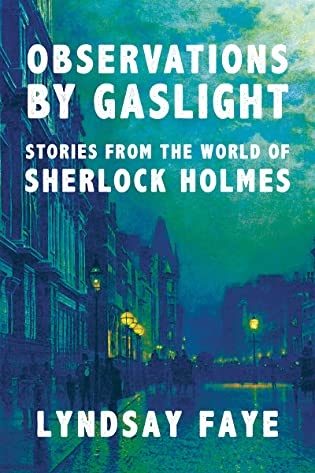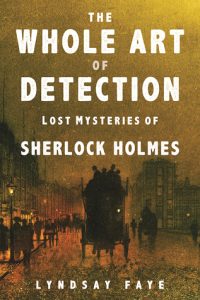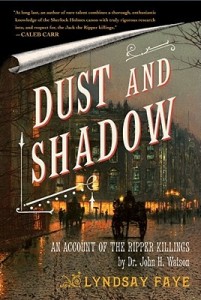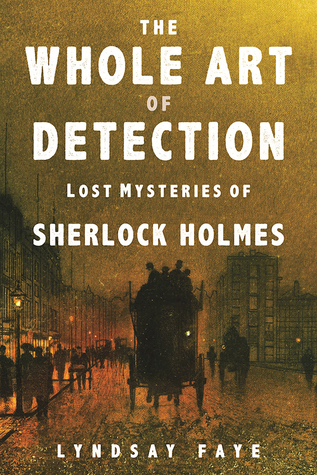 Observations by Gaslight: Stories from the World of Sherlock Holmes by Lyndsay Faye
Observations by Gaslight: Stories from the World of Sherlock Holmes by Lyndsay Faye Format: eARC
Source: supplied by publisher via Edelweiss
Formats available: hardcover, paperback
Genres: historical mystery, mystery
Pages: 295
Published by Mysterious Press on December 21, 2021
Purchasing Info: Author's Website, Publisher's Website, Amazon, Barnes & Noble, Kobo, Bookshop.org
Goodreads
Lyndsay Faye—international bestseller, translated into fifteen languages, and a two-time Edgar Award nominee—first appeared on the literary scene with Dust and Shadow, her now-classic novel pitting Sherlock Holmes against Jack the Ripper, and later produced The Whole Art of Detection, her widely acclaimed collection of traditional Watsonian tales. Now Faye is back with Observations by Gaslight, a thrilling volume of both new and previously published short stories and novellas narrated by those who knew the Great Detective.
Beloved adventuress Irene Adler teams up with her former adversary in a near-deadly inquiry into a room full of eerily stopped grandfather clocks. Learn of the case that cemented the lasting friendship between Holmes and Inspector Lestrade, and of the tragic crime which haunted the Yarder into joining the police force. And witness Stanley Hopkins’ first meeting with the remote logician he idolizes, who will one day become his devoted mentor.
From familiar faces like landlady Mrs. Hudson to minor characters like Lomax the sub-librarian, Observations by Gaslight—entirely epistolary, told through diaries, telegrams, and even grocery lists—paints a masterful portrait of Sherlock Holmes and Dr. Watson as you have never seen them before.
My Review:
 There’s a conceit in regards to Sherlock Holmes stories, beginning with Doyle himself. That Doyle was merely the publisher of stories written by Dr. John H. Watson that were somewhat sensationalized accounts of Watson’s adventures with his friend and flatmate, Sherlock Holmes.
There’s a conceit in regards to Sherlock Holmes stories, beginning with Doyle himself. That Doyle was merely the publisher of stories written by Dr. John H. Watson that were somewhat sensationalized accounts of Watson’s adventures with his friend and flatmate, Sherlock Holmes.
So it is with the collection, that someone is putting together a book or booklet of previously unknown Holmes adventures, written by people who were occasional or even frequent assistants to the “Great Detective”. As this book is to be published in commemoration of Holmes’ retirement from public life, the collator of this volume has reached out to acquaintances of Holmes throughout his career, ranging from his housekeeper Mrs. Hudson to his former lieutenant Henry Wiggins to his frequent foil Inspector Lestrade.
With, naturally, a contribution from “the Woman” herself, Irene Norton née Adler recounting the one time that she and Holmes were on the same side of a thorny and fascinating case.
There are six stories in this collection, with the entries rounded out by contributions from two minor characters in the Holmes canon, Detective Stanley Hopkins and the sub-librarian A. Davenport Lomax who becomes acquainted with Holmes through his long-standing friendship with Watson.
The stories range from the slight to the profound. Mrs. Hudson’s story, “A Life Well Lived,” is one of the slighter – and also fluffier – works in the collection. There is a small mystery to be solved, but the heart of the story is on Mrs. Hudson’s reflections that her life has been richer and more satisfying because of the occasionally explosive presence of Sherlock Holmes and John Watson in the flat she offered for rent so many years before.
Lomax’ story, “The Gospel of Sheba,” is also a bit on the lesser side, as Holmes himself doesn’t appear until nearly the end, and most of the mystery is wrapped around Lomax’ fears regarding his absent wife’s fidelity and his nearly-fatal idiocy surrounding his own investigation of a poisoned book.
Hopkins’ story, “The River of Silence,” shows Holmes in the role of mentor to the young police inspector, a role that surprises and delights and is perfect for the length of the story.
But the shining lights of this collection belong to Adler, Wiggins and Lestrade. Adler’s contribution, “The Adventure of the Stopped Clocks,” shines as brightly as the footlights that illuminate the opera stages which are her accustomed milieu. This story, unlike Adler’s famous introduction to Holmes, “A Scandal in Bohemia,” places “The Woman” and “The Great Detective” on the same side, investigating a criminal organization that has its hooks into Holmes’ beloved London in general, and Adler’s despicable in-laws in specific. What makes this story sing is its portrayal of their brief but brilliant collaboration as not just colleagues, but also friends for this one sparkling moment in time.
On the other hand, both Wiggins’ story, “The Song of a Want,” and Lestrade’s, “Our Common Correspondent,” are heartbreaking in their sorrow.
Wiggins, now a prosperous and successful solicitor, looks back on his days as a mudlark, when Holmes, himself younger and considerably poorer, teamed up with 9-year-old Wiggins to find a kidnapped young girl, bring down a sick and twisted criminal preying on the young and the desperate, and scratch out the humble beginnings of an organization that became the bane of criminals throughout London, the famous ‘Baker Street Irregulars’.
At least Wiggins’ story, as dark and desperate as it seems in the middle, manages to scrape out a happy ending. Lestrade’s account of his first ‘case’ with Holmes and the tragedy that turned him towards a career bringing criminals to justice is a story about one man who is keeping on keeping on a quest that can never be fulfilled and a grief that can never be assuaged. The light that shines through this story is the kind that is seen through a glass very darkly indeed. It’s a story that inspires both weeping and rage. As it should.
 Escape Rating A-: This review is just a bit early, but I couldn’t resist picking this one up now. I’m considering it a Hanukkah present – and a marvelous one for any reader who loves Sherlock Holmes stories as I do.
Escape Rating A-: This review is just a bit early, but I couldn’t resist picking this one up now. I’m considering it a Hanukkah present – and a marvelous one for any reader who loves Sherlock Holmes stories as I do.
My first exposure to the author of this collection was through her utterly marvelous Dust and Shadow, an account of Holmes’ involvement with the Ripper case. There have been plenty of attempts to portray Holmes assaying that investigation, but Dust and Shadow is still the best, the most true to both the Holmes we know and love from the canon and the known facts about the infamous Ripper.
Her previous Holmes collection, The Whole Art of Detection, was equally marvelous and definitely worth a read.
As is this one, Observations by Gaslight. Of the six stories, two weren’t quite up to snuff, but “The Song of a Want”, “Our Common Correspondent” and “The Adventure of the Stopped Clocks” absolutely made the entire collection a terrific read and a great way to while away a chilly fall evening by whisking the reader away to sit in front of a warm fire at 221B Baker Street in the midst of a London pea-souper. If only for a little while.

 The Whole Art of Detection: Lost Mysteries of Sherlock Holmes by
The Whole Art of Detection: Lost Mysteries of Sherlock Holmes by